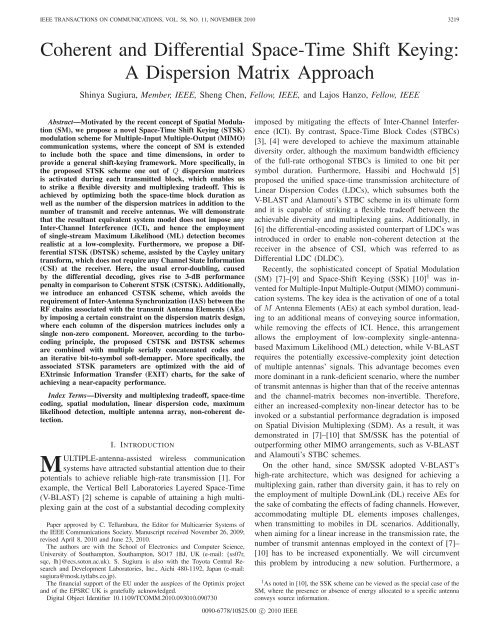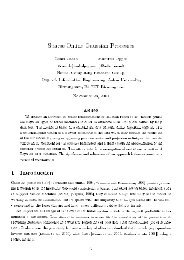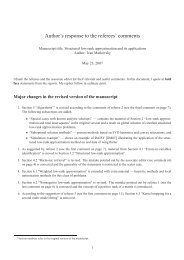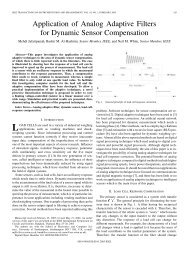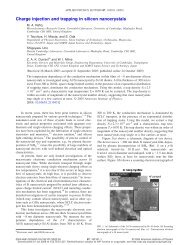Coherent and Differential Space-Time Shift Keying - ECS EPrints ...
Coherent and Differential Space-Time Shift Keying - ECS EPrints ...
Coherent and Differential Space-Time Shift Keying - ECS EPrints ...
Create successful ePaper yourself
Turn your PDF publications into a flip-book with our unique Google optimized e-Paper software.
IEEE TRANSACTIONS ON COMMUNICATIONS, VOL. 58, NO. 11, NOVEMBER 2010 3219<br />
<strong>Coherent</strong> <strong>and</strong> <strong>Differential</strong> <strong>Space</strong>-<strong>Time</strong> <strong>Shift</strong> <strong>Keying</strong>:<br />
A Dispersion Matrix Approach<br />
Shinya Sugiura, Member, IEEE, Sheng Chen, Fellow, IEEE, <strong>and</strong> Lajos Hanzo, Fellow, IEEE<br />
Abstract—Motivated by the recent concept of Spatial Modulation<br />
(SM), we propose a novel <strong>Space</strong>-<strong>Time</strong> <strong>Shift</strong> <strong>Keying</strong> (STSK)<br />
modulation scheme for Multiple-Input Multiple-Output (MIMO)<br />
communication systems, where the concept of SM is extended<br />
to include both the space <strong>and</strong> time dimensions, in order to<br />
provide a general shift-keying framework. More specifically, in<br />
the proposed STSK scheme one out of
3220 IEEE TRANSACTIONS ON COMMUNICATIONS, VOL. 58, NO. 11, NOVEMBER 2010<br />
coherently detected SM/SSK scheme requires Channel State<br />
Information (CSI) at the receiver, although it is a challenging<br />
task to acquire accurate CSI for high-speed vehicles, which<br />
may require a high pilot overhead <strong>and</strong> imposes a substantial<br />
processing complexity. The resultant CSI estimation error is<br />
expected to erode the achievable performance.<br />
Against this background the novel contributions of this<br />
paper are as follows:<br />
1) Inspired by the SM/SSK scheme, we propose the novel<br />
concept of <strong>Space</strong>-<strong>Time</strong> <strong>Shift</strong> <strong>Keying</strong> (STSK) modulation,<br />
which constitutes a generalized shift-keying architecture<br />
utilizing both the space as well as time dimensions<br />
<strong>and</strong> hence includes the SM <strong>and</strong> SSK schemes<br />
as special cases. More specifically, the STSK scheme<br />
is based on the activation of
SUGIURA et al.: COHERENT AND DIFFERENTIAL SPACE-TIME SHIFT KEYING: A DISPERSION MATRIX APPROACH 3221<br />
TABLE I<br />
EXAMPLE OF STSK MODULATION SCHEME,MAPPING 3BITS PER SPACE-TIME BLOCK, WITH THE AID OF L–PSK CONSTELLATION
3222 IEEE TRANSACTIONS ON COMMUNICATIONS, VOL. 58, NO. 11, NOVEMBER 2010
SUGIURA et al.: COHERENT AND DIFFERENTIAL SPACE-TIME SHIFT KEYING: A DISPERSION MATRIX APPROACH 3223<br />
Source<br />
S/P<br />
Fig. 2. Transmitter structure of our DSTSK scheme.<br />
DSTSK block<br />
D. Computational Complexity<br />
Let us now characterize the computational complexity imposed<br />
by the ML detection of our CSTSK scheme for both<br />
rapid <strong>and</strong> slow fading, which are given, respectively, by<br />
⎧
3224 IEEE TRANSACTIONS ON COMMUNICATIONS, VOL. 58, NO. 11, NOVEMBER 2010<br />
III. THREE-STAGE CONCATENATED TURBO STSK<br />
SCHEME<br />
Let us invoke the turbo principle [12] to incorporate the<br />
proposed CSTSK <strong>and</strong> DSTSK schemes of Section II in a<br />
multiple-stage serially concatenated arrangement, for the sake<br />
of achieving a near-capacity performance. Furthermore, the<br />
iterative soft demapping principle is derived for our STSK<br />
scheme. Additionally, the capacity of our CSTSK scheme is<br />
also characterized.<br />
A. System Overview<br />
Fig. 3 shows the schematic of the proposed three-stage<br />
channel- <strong>and</strong> Unity Rate-Coded (URC) STSK scheme using<br />
iterative detection. Here, the input source bits are channelencoded<br />
by a half-rate Recursive Systematic Convolutional<br />
(RSC) code <strong>and</strong> are interleaved by a r<strong>and</strong>om bit interleaver Π1.<br />
Then, the interleaved bits are further encoded by a recursive<br />
URC encoder [16] 5 , <strong>and</strong> then the coded bits are interleaved<br />
by the second r<strong>and</strong>om interleaver Π2 of Fig. 3. Finally, the<br />
interleaved bits are input to the CSTSK block of Fig. 1 or<br />
DSTSK block of Fig. 2, followed by the transmission of the<br />
space-time block
SUGIURA et al.: COHERENT AND DIFFERENTIAL SPACE-TIME SHIFT KEYING: A DISPERSION MATRIX APPROACH 3225<br />
Source<br />
Outer code Inner code<br />
Channel<br />
encoder<br />
Channel<br />
decoder<br />
Unity-rate<br />
encoder<br />
Unity-rate<br />
decoder<br />
CSTSK<br />
/DSTSK<br />
block<br />
CSTSK<br />
/DSTSK<br />
demapper<br />
<strong>Space</strong>-time<br />
1<br />
<br />
mapper<br />
Fig. 3. Schematic of a three-stage RSC- <strong>and</strong> URC-coded coherent or differential STSK scheme using iterative detection.<br />
∑
3226 IEEE TRANSACTIONS ON COMMUNICATIONS, VOL. 58, NO. 11, NOVEMBER 2010<br />
exhibits a system structure, which is identical to that of<br />
the SM/SSK scheme employing (
SUGIURA et al.: COHERENT AND DIFFERENTIAL SPACE-TIME SHIFT KEYING: A DISPERSION MATRIX APPROACH 3227<br />
R<br />
E<br />
B<br />
10 0<br />
10 -1<br />
10 -2<br />
10 -3<br />
10 -4<br />
10 -5<br />
10 -6<br />
0 5 10 15 20 25 30<br />
SNR [dB]<br />
BPSK<br />
CSTSK(2,2,2,Q),<br />
bound<br />
upper<br />
Q = 1, 2, 4 <strong>and</strong> 8<br />
Fig. 5. Achievable BER curves of our CSTSK(2, 2, 2,
3228 IEEE TRANSACTIONS ON COMMUNICATIONS, VOL. 58, NO. 11, NOVEMBER 2010<br />
Fig. 9. Achievable BER curves of our CSTSK(2, 2, 2,
SUGIURA et al.: COHERENT AND DIFFERENTIAL SPACE-TIME SHIFT KEYING: A DISPERSION MATRIX APPROACH 3229<br />
I E<br />
1.0<br />
0.8<br />
0.6<br />
0.4<br />
0.2<br />
= -2.0 dB to 3 dB<br />
SNR<br />
of 0.5 dB)<br />
(step<br />
QPSK<br />
CSTSK(2,2,2,4),<br />
RSC(2,1,2)<br />
200 000 bits<br />
Trajectory,<br />
= -0.5 dB<br />
SNR<br />
0.0<br />
0.4 0.6 0.8 1.0<br />
0.2 0.0<br />
Fig. 11. EXIT chart of our QPSK-modulated CSTSK(2, 2, 2, 4) system.The<br />
outer EXIT curve of the half-rate RSC(2, 1, 2) code was also plotted.<br />
b<br />
o<br />
l]<br />
2.0 m<br />
its<br />
/s<br />
y<br />
[<br />
b 1.5<br />
ity<br />
c<br />
1.0 a<br />
C<br />
a<br />
p<br />
3.0<br />
2.5<br />
0.5<br />
0.0<br />
0 5 10 15 20<br />
-5 -10<br />
I A<br />
QPSK, CCMC<br />
CSTSK(2,2,2,4),<br />
QPSK, DCMC<br />
CSTSK(2,2,2,4),<br />
QPSK, maximum achievable rate<br />
CSTSK(2,2,2,4),<br />
(M,)=(2,2), BPSK, DCMC<br />
SM,<br />
SNR [dB]<br />
Fig. 12. B<strong>and</strong>width efficiency of our CSTSK(2, 2, 2, 4) system employing<br />
QPSK modulation, comparing the CCMC capacity, the DCMC capacity <strong>and</strong><br />
the maximum achievable rate. The DCMC capacity of the BPSK-modulated<br />
SM employing (
3230 IEEE TRANSACTIONS ON COMMUNICATIONS, VOL. 58, NO. 11, NOVEMBER 2010<br />
REFERENCES<br />
[1] L. Hanzo, O. Alamri, M. El-Hajjar, <strong>and</strong> N. Wu, Near-Capacity Multi-<br />
Functional MIMO Systems: Sphere-Packing, Iterative Detection <strong>and</strong><br />
Cooperation. John Wiley <strong>and</strong> IEEE Press, 2009.<br />
[2] P. Wolniansky, G. Foschini, G. Golden, <strong>and</strong> R. Valenzuela, “V-BLAST:<br />
an architecture for realizing very high data rates over the rich-scattering<br />
wireless channel," in Proc. International Symp. Signals, Syst., Electron.,<br />
Pisa, Italy, 1998, pp. 295-300.<br />
[3] S. Alamouti, “A simple transmit diversity technique for wireless communications,"<br />
IEEE J. Sel. Areas Commun., vol. 16, no. 8, pp. 1451-1458,<br />
1998.<br />
[4] V. Tarokh, N. Seshadri, <strong>and</strong> A. Calderbank, “<strong>Space</strong>-time codes for<br />
high data rate wireless communication: performance criterion <strong>and</strong> code<br />
construction," IEEE Trans. Inf. Theory, vol. 44, no. 2, pp. 744-765,<br />
1998.<br />
[5] B. Hassibi <strong>and</strong> B. Hochwald, “High-rate codes that are linear in space<br />
<strong>and</strong> time," IEEE Trans. Inf. Theory, vol. 48, no. 7, pp. 1804-1824, 2002.<br />
[6] ——, “Cayley differential unitary space-time codes," IEEE Trans. Inf.<br />
Theory, vol. 48, no. 6, pp. 1485-1503, 2002.<br />
[7] R. Mesleh, H. Haas, C. Ahn, <strong>and</strong> S. Yun, “Spatial modulation—a new<br />
low complexity spectral efficiency enhancing technique," in Proc. First<br />
International Conf. Commun. Netw., Beijing, China, Oct. 2006, pp. 1-5.<br />
[8] R. Mesleh, H. Haas, S. Sinanovic, C. Ahn, <strong>and</strong> S. Yun, “Spatial<br />
modulation," IEEE Trans. Veh. Technol., vol. 57, no. 4, pp. 2228-2242,<br />
2008.<br />
[9] J. Jeganathan, A. Ghrayeb, <strong>and</strong> L. Szczecinski, “Spatial modulation:<br />
optimal detection <strong>and</strong> performance analysis," IEEE Commun. Lett.,<br />
vol. 12, no. 8, pp. 545-547, 2008.<br />
[10] J. Jeganathan, A. Ghrayeb, L. Szczecinski, <strong>and</strong> A. Ceron, “<strong>Space</strong><br />
shift keying modulation for MIMO channels," IEEE Trans. Wireless<br />
Commun., vol. 8, no. 7, pp. 3692-3703, 2009.<br />
[11] M. Di Renzo <strong>and</strong> H. Haas, “Performance comparison of different spatial<br />
modulation schemes in correlated fading channels," in Proc. IEEE<br />
International Conf. Commun., Cape Town, South Africa, May 2010,<br />
pp. 1-6.<br />
[12] L. Hanzo, T. Liew, <strong>and</strong> B. Yeap, Turbo Coding, Turbo Equalisation,<br />
<strong>and</strong> <strong>Space</strong>-<strong>Time</strong> Coding for Transmission over Fading Channels. John<br />
Wiley <strong>and</strong> IEEE Press, 2002.<br />
[13] A. Ashikhmin, G. Kramer, <strong>and</strong> S. Ten Brink, “Extrinsic information<br />
transfer functions: model <strong>and</strong> erasure channel properties," IEEE Trans.<br />
Inf. Theory, vol. 50, no. 11, pp. 2657-2673, 2004.<br />
[14] R. Heath Jr <strong>and</strong> A. Paulraj, “Linear dispersion codes for MIMO systems<br />
based on frame theory," IEEE Trans. Signal Process., vol. 50, no. 10,<br />
pp. 2429-2441, 2002.<br />
[15] V. Tarokh, N. Seshadri, <strong>and</strong> A. Calderbank, “<strong>Space</strong>-time codes for<br />
high data rate wireless communication: performance criterion <strong>and</strong> code<br />
construction," IEEE Trans. Inf. Theory, vol. 44, no. 2, pp. 744-765,<br />
1998.<br />
[16] D. Divsalar, S. Dolinar, <strong>and</strong> F. Pollara, “Serial concatenated trellis coded<br />
modulation with rate-1 inner code," in Proc. IEEE Global Telecommun.<br />
Conf., vol. 2, San Francisco, CA, Nov. 2000, pp. 777-782.<br />
[17] S. ten Brink, “Convergence behavior of iteratively decoded parallel<br />
concatenated codes," IEEE Trans. Commun., vol. 49, no. 10, pp. 1727-<br />
1737, 2001.<br />
[18] S. Ng <strong>and</strong> L. Hanzo, “On the MIMO channel capacity of multidimensional<br />
signal sets," IEEE Trans. Veh. Technol., vol. 55, no. 2, pp. 528-<br />
536, 2006.<br />
[19] J. Proakis, Digital Communications. McGraw-Hill, 2001.<br />
[20] J. Jeganathan, A. Ghrayeb, <strong>and</strong> L. Szczecinski, “Generalized space<br />
shift keying modulation for MIMO channels," in Proc. IEEE 19th<br />
International Symp. Personal, Indoor Mobile Radio Commun., Cannes,<br />
France, Sep. 2008, pp. 1-5.<br />
[21] V. Tarokh, S. Alamouti, <strong>and</strong> P. Poon, “New detection schemes for<br />
transmit diversity with no channel estimation," in Proc. International<br />
Conf. Universal Personal Commun., vol. 2, 1998, pp. 917-920.<br />
[22] V. Tarokh, H. Jafarkhani, <strong>and</strong> A. Calderbank, “<strong>Space</strong>-time block coding<br />
for wireless communications: performance results," IEEE J. Sel. Areas<br />
Commun., vol. 17, no. 3, pp. 451-460, 1999.<br />
[23] M. Tüchler, “Design of serially concatenated systems depending on the<br />
block length," IEEE Trans. Commun., vol. 52, no. 2, pp. 209-218, 2004.<br />
Shinya Sugiura (M’06) received the B.S. <strong>and</strong> M.S.<br />
degrees in aeronautics <strong>and</strong> astronautics from Kyoto<br />
University, Kyoto, Japan, in 2002 <strong>and</strong> 2004, respectively.<br />
In 2004, he joined Toyota Central Research<br />
<strong>and</strong> Development Laboratories (CRDL), Inc., Aichi,<br />
Japan. Since 2007 he has been with the School<br />
of Electronics <strong>and</strong> Computer Science, University<br />
of Southampton, Southampton, UK, on leave from<br />
Toyota CRDL Inc., where he is currently working<br />
towards the Ph.D. degree. His research has covered a<br />
range of areas in communications, including spacetime<br />
modulation <strong>and</strong> demodulation, turbo coding, cooperative communications,<br />
multiuser detection, automotive antenna design as well as vehicular ad<br />
hoc networking. He has published over 20 research papers in various journals<br />
<strong>and</strong> conference proceedings. He was awarded IEEE AP-S Japan Chapter<br />
Young Engineer Award in December 2008.<br />
Sheng Chen (M’90-SM’97-F’08) obtained a BEng<br />
degree from the East China Petroleum Institute,<br />
Dongying, China, in 1982, <strong>and</strong> a PhD degree from<br />
the City University, London, in 1986, both in control<br />
engineering. In 2005, he was awarded DSc<br />
from the University of Southampton, Southampton,<br />
UK. Since 1999 he has been with the School of<br />
Electronics <strong>and</strong> Computer Science, the University<br />
of Southampton, UK. He previously held research<br />
<strong>and</strong> academic appointments at the Universities of<br />
Sheffield, Edinburgh <strong>and</strong> Portsmouth, all in UK.<br />
Professor Chen’s recent research works include adaptive signal processing,<br />
wireless communications, modelling <strong>and</strong> identification of nonlinear systems,<br />
neural network <strong>and</strong> machine learning, finite-precision digital controller design,<br />
evolutionary computation methods, <strong>and</strong> optimization. He has published over<br />
280 research papers. In the database of the world’s most highly cited<br />
researchers in various disciplines, compiled by Institute for Scientific Information<br />
(ISI) of the USA, Prof. Chen is on the list of the highly cited researchers<br />
in the engineering category, see http://www.ISIHighlyCited.com.<br />
Lajos Hanzo (http://www-mobile.ecs.soton.ac.uk)<br />
FREng, FIEEE, FIET, DSc received his degree in<br />
electronics in 1976 <strong>and</strong> his doctorate in 1983. During<br />
his 34-year career in telecommunications he<br />
has held various research <strong>and</strong> academic posts in<br />
Hungary, Germany <strong>and</strong> the UK. Since 1986 he has<br />
been with the School of Electronics <strong>and</strong> Computer<br />
Science, University of Southampton, UK, where he<br />
holds the chair in telecommunications. He has coauthored<br />
20 John Wiley - IEEE Press books on<br />
mobile radio communications totalling in excess of<br />
10 000 pages, published 880 research papers <strong>and</strong> book chapters at IEEE<br />
Xplore, acted as TPC Chair of IEEE conferences, presented keynote lectures<br />
<strong>and</strong> been awarded a number of distinctions. Currently he is directing an<br />
academic research team, working on a range of research projects in the field of<br />
wireless multimedia communications sponsored by industry, the Engineering<br />
<strong>and</strong> Physical Sciences Research Council (EPSRC) UK, the European IST<br />
Programme <strong>and</strong> the Mobile Virtual Centre of Excellence (VCE), UK. He is an<br />
enthusiastic supporter of industrial <strong>and</strong> academic liaison <strong>and</strong> he offers a range<br />
of industrial courses. He is also an IEEE Distinguished Lecturer as well as a<br />
Governor of both the IEEE ComSoc <strong>and</strong> the VTS. He is the Editor-in-Chief<br />
of the IEEE Press <strong>and</strong> a Chaired Prof. also at Tsinghua University, Beijing.<br />
For further information on research in progress <strong>and</strong> associated publications<br />
please refer to http://www-mobile.ecs.soton.ac.uk


